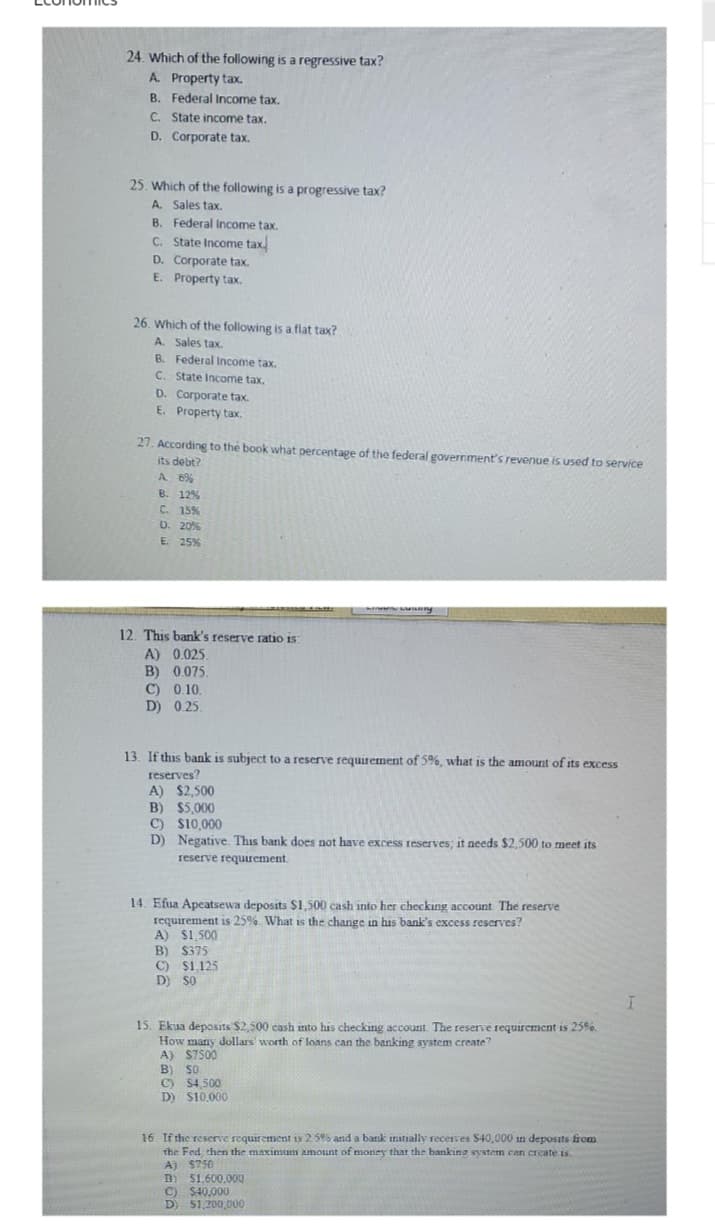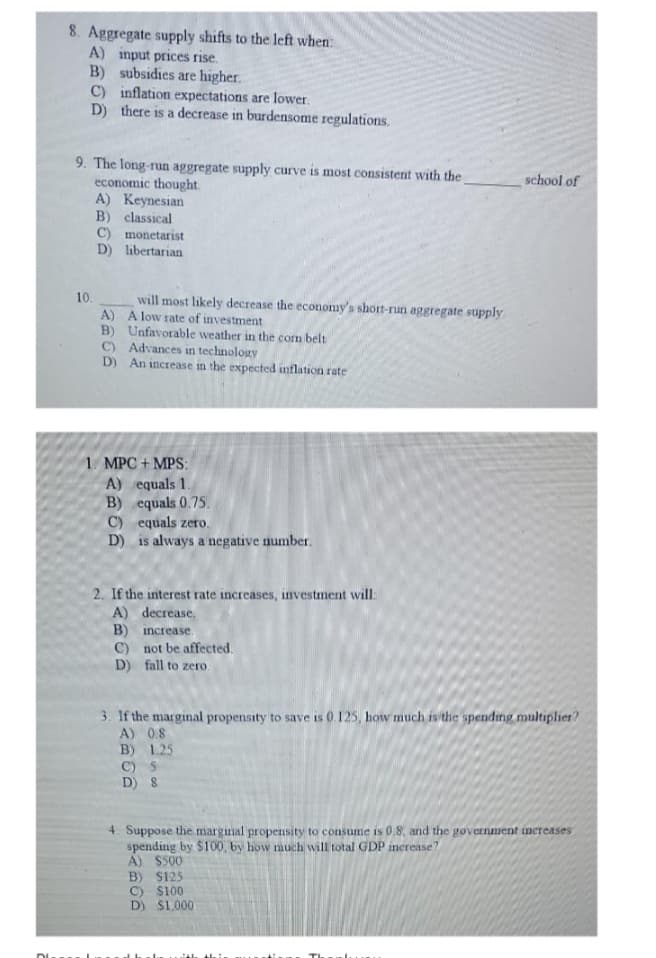P B 24. Which of the following is a regressive tax? A Property tax. B. Federal Income tax. C. State income tax. Corporate tax. D. 25. Which of the following is a progressive tax? A Sales tax. B. Federal Income tax. C. State Income tax D. Corporate tax. E. Property tax. 26. Which of the following is a flat tax? A. Sales tax B. Federal Income tax. C. State Income tax. D. Corporate tax. E. Property tax 27. According to the book what percentage of the federal government's revenue is used to service its debt? A 6% B. 12 % C. 15 % D. 20% E. 25 % 12. This bank's reserve ratio is A) 0.025 B) 0.075. C) 0.10. D) 0.25. 13. If this bank is subject to a reserve requirement of 5%, what is the amount of its excess reserves? A) $2,500 B) $5,000 C) $10,000 D) Negative. This bank does not have excess reserves; it needs $2,500 to meet its reserve requirement. 14. Efua Apeatsewa deposits $1,500 cash into her checking account. The reserve requirement is 25%. What is the change in his bank's excess reserves? A) $1,500 B) $375 C) $1,125 D) SO 15. Ekua deposits $2,500 cash into his checking account. The reserve requirement is 25% How many dollars worth of loans can the banking system create? A) $7500 B) 50 C) $4,500 D) $10,000 16. If the reserve requirement is 2 5% and a bank initially receives $40,000 in deposits from the Fed then the maximum amount of money that the banking system can create is. A) $750 B) 51.600.000 C) $40,000 D) $1,200,000
P B 24. Which of the following is a regressive tax? A Property tax. B. Federal Income tax. C. State income tax. Corporate tax. D. 25. Which of the following is a progressive tax? A Sales tax. B. Federal Income tax. C. State Income tax D. Corporate tax. E. Property tax. 26. Which of the following is a flat tax? A. Sales tax B. Federal Income tax. C. State Income tax. D. Corporate tax. E. Property tax 27. According to the book what percentage of the federal government's revenue is used to service its debt? A 6% B. 12 % C. 15 % D. 20% E. 25 % 12. This bank's reserve ratio is A) 0.025 B) 0.075. C) 0.10. D) 0.25. 13. If this bank is subject to a reserve requirement of 5%, what is the amount of its excess reserves? A) $2,500 B) $5,000 C) $10,000 D) Negative. This bank does not have excess reserves; it needs $2,500 to meet its reserve requirement. 14. Efua Apeatsewa deposits $1,500 cash into her checking account. The reserve requirement is 25%. What is the change in his bank's excess reserves? A) $1,500 B) $375 C) $1,125 D) SO 15. Ekua deposits $2,500 cash into his checking account. The reserve requirement is 25% How many dollars worth of loans can the banking system create? A) $7500 B) 50 C) $4,500 D) $10,000 16. If the reserve requirement is 2 5% and a bank initially receives $40,000 in deposits from the Fed then the maximum amount of money that the banking system can create is. A) $750 B) 51.600.000 C) $40,000 D) $1,200,000
Economics (MindTap Course List)
13th Edition
ISBN:9781337617383
Author:Roger A. Arnold
Publisher:Roger A. Arnold
Chapter11: Fiscal Policy And The Federal Budget
Section: Chapter Questions
Problem 5WNG
Related questions
Question
E1

Transcribed Image Text:24. Which of the following is a regressive tax?
A Property tax.
B.
Federal Income tax.
C. State income tax.
Corporate tax.
D.
25. Which of the following is a progressive tax?
A. Sales tax.
B. Federal Income tax.
C. State Income tax
D. Corporate tax.
E. Property tax.
26. Which of the following is a flat tax?
A. Sales tax.
B. Federal Income tax.
C. State Income tax,
D. Corporate tax.
E. Property tax.
27. According to the book what percentage of the federal government's revenue is used to service
its debt?
A 6%
B. 12%
C. 15%
D. 20%
E. 25%
12. This bank's reserve ratio is
A) 0.025
B) 0.075.
C) 0.10.
D) 0.25.
13. If this bank is subject to a reserve requirement of 5%, what is the amount of its excess
reserves?
A) $2,500
B) $5,000
C) $10,000
D) Negative. This bank does not have excess reserves; it needs $2,500 to meet its
reserve requirement.
Lung
14. Efua Apeatsewa deposits $1,500 cash into her checking account. The reserve
requirement is 25%. What is the change in his bank's excess reserves?
A) $1,500
B) $375
C) $1,125
D) SO
15. Ekua deposits $2,500 cash into his checking account. The reserve requirement is 25%.
How many dollars worth of loans can the banking system create?
A) $7500
B) 50
C) $4,500
D) $10,000
16. If the reserve requirement is 2.5% and a bank initially receives $40,000 in deposits from
the Fed then the maximum amount of money that the banking system can create is.
A) $750
B)
C) $40,000
D) $1,200,000
51.600.000
I

Transcribed Image Text:8. Aggregate supply shifts to the left when:
A) input prices rise.
B) subsidies are higher.
C) inflation expectations are lower.
D) there is a decrease in burdensome regulations.
9. The long-run aggregate supply curve is most consistent with the
economic thought.
A) Keynesian
B) classical
C) monetarist
D) libertarian
10.
will most likely decrease the economy's short-run aggregate supply
A low rate of investment
A)
B)
C) Advances in technology
D) An increase in the expected inflation rate
Unfavorable weather in the corn belt
1. MPC + MPS:
A) equals 1.
B) equals 0.75.
C) equals zero.
D) is always a negative number.
2. If the interest rate increases, investment will:
A) decrease.
B) increase.
C) not be affected.
D) fall to zero.
school of
3. If the marginal propensity to save is 0.125, how much is the spending multiplier?
A) 0.8
B) 1.25
C) 5
D) S
4. Suppose the marginal propensity to consume is 0.8, and the government increases
spending by $100, by how much will total GDP increase?
A) $500
B) $125
C) $100
D) $1,000
Expert Solution
This question has been solved!
Explore an expertly crafted, step-by-step solution for a thorough understanding of key concepts.
Step by step
Solved in 2 steps

Knowledge Booster
Learn more about
Need a deep-dive on the concept behind this application? Look no further. Learn more about this topic, economics and related others by exploring similar questions and additional content below.Recommended textbooks for you

Economics (MindTap Course List)
Economics
ISBN:
9781337617383
Author:
Roger A. Arnold
Publisher:
Cengage Learning


Brief Principles of Macroeconomics (MindTap Cours…
Economics
ISBN:
9781337091985
Author:
N. Gregory Mankiw
Publisher:
Cengage Learning

Economics (MindTap Course List)
Economics
ISBN:
9781337617383
Author:
Roger A. Arnold
Publisher:
Cengage Learning


Brief Principles of Macroeconomics (MindTap Cours…
Economics
ISBN:
9781337091985
Author:
N. Gregory Mankiw
Publisher:
Cengage Learning

Principles of Microeconomics
Economics
ISBN:
9781305156050
Author:
N. Gregory Mankiw
Publisher:
Cengage Learning

